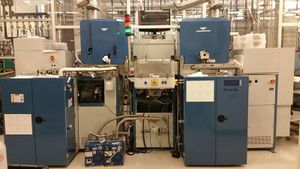Atomic Layer Deposition (Oxford FlexAL): Difference between revisions
→About: explained dual-chamber setup, added 50nm restriction |
Update SOP rev |
||
| (16 intermediate revisions by 4 users not shown) | |||
| Line 1: | Line 1: | ||
{{ |
{{tool2|{{PAGENAME}} |
||
|picture=FlexAL.jpg |
|picture=FlexAL.jpg |
||
|type = Vacuum Deposition |
|type = Vacuum Deposition |
||
|super= |
|super= Bill Millerski |
||
|super2= Lee Sawyer |
|||
|phone=(805)839- |
|phone=(805)839-2655 |
||
|location=Bay 2 |
|location=Bay 2 |
||
|email= |
|email=wmillerski@ucsb.edu |
||
|description = Oxford FlexAL Atomic Layer Deposition |
|description = Oxford FlexAL Atomic Layer Deposition |
||
|manufacturer = [http://www.oxford-instruments.com/businesses/plasma-technology/Pages/plasma-technology.aspx Oxford Instruments Plasma Technologies] |
|manufacturer = [http://www.oxford-instruments.com/businesses/plasma-technology/Pages/plasma-technology.aspx Oxford Instruments Plasma Technologies] |
||
| Line 11: | Line 12: | ||
|toolid=6 |
|toolid=6 |
||
}} |
}} |
||
= |
=About= |
||
The Oxford Instruments FlexAL Atomic Layer Deposition system at UCSB is a plasma-enhanced ALD system for the precise growth of ultra-thin oxides and nitrides. Self-limiting layer by layer growth ensures precise control, film conformality, and repeatability of the films. |
The Oxford Instruments FlexAL Atomic Layer Deposition system at UCSB is a plasma-enhanced ALD system for the precise growth of ultra-thin oxides and nitrides. Self-limiting layer by layer growth ensures precise control, film conformality, and repeatability of the films. |
||
The system currently has metallorganic precursors for Aluminum, Hafnium, Titanium, Platinum, Zirconium, and Silicon oxides and nitrides. Water and Ozone are available for thermal oxides and Oxygen, Ammonia, Nitrogen, and Hydrogen are available for plasma assisted oxides and nitrides. Remote ICP plasma powers up to 600W are possible. |
The system currently has metallorganic precursors for Aluminum, Hafnium, Titanium, Platinum, Zirconium, and Silicon oxides and nitrides as well as Ruthenium and Platinum. Water and Ozone are available for thermal oxides and Oxygen, Ammonia, Nitrogen, and Hydrogen are available for plasma assisted oxides and nitrides. Remote ICP plasma powers up to 600W are possible. |
||
The system is load-locked and can accommodate sample temperatures up to 550°C. Processing temperature windows are defined for each material based on growth limitations. The system is step-by-step programmable through a flexible GUI interface. |
The system is load-locked and can accommodate sample temperatures up to 550°C. Processing temperature windows are defined for each material based on growth limitations. The system is step-by-step programmable through a flexible GUI interface. |
||
===Cluster Configuration=== |
|||
| ⚫ | |||
| ⚫ | |||
| ⚫ | |||
| ⚫ | |||
*[[media:Cluster operating instructions.pdf|Operating Instructions]] |
|||
| ⚫ | |||
*Chamber #1: ALD: Al2O3, SiO2, Ru, Pt, Al:ZnO |
|||
| ⚫ | |||
*Chamber #2: [[CAIBE (Oxford Ion Mill)|Oxford Ion Mill (CAIBE)]] |
|||
| ⚫ | |||
*Chamber #3: Al2O3, SiO2, HfO2, ZrO2, TiN |
|||
| ⚫ | |||
| ⚫ | |||
| ⚫ | |||
** Chamber #1: Dielectrics Films only |
|||
** Chamber #3: Metal Films only |
|||
*[https://wiki.nanotech.ucsb.edu/w/images/4/40/Oxford_Cluster_Tool_Operating_Instructions_Rev_B.pdf Operating Instructions] |
|||
* Film Thicknesses are restricted to '''50nm or less'''. Thicker films must be deposited on a different tool, unless specifically given staff permission to do so. |
|||
| ⚫ | |||
*Film Thicknesses are restricted to '''30nm or less'''. |
|||
**'''Thicker films are allowed with prior staff approval''' - please ask [[Brian Lingg|Tool Supervisor]] if you want to deposit a thicker film! |
|||
| ⚫ | |||
| ⚫ | |||
| ⚫ | |||
==Etch Rates of ALD Films== |
==Etch Rates of ALD Films== |
||
*[[media:Wet Etching of ALD Al2O3 Plasma 300C.xls|Al2O3 Plasma 300C Wet Etch Rates]] |
|||
*[//wiki.nanotech.ucsb.edu/wiki/images/1/14/Wet_Etching_of_ALD_Al2O3_Plasma_300C.xls Al2O3 Plasma 300C Wet Etch Rates] |
|||
Latest revision as of 21:56, 8 March 2023
| ||||||||||||||||||||||||||||||
About
The Oxford Instruments FlexAL Atomic Layer Deposition system at UCSB is a plasma-enhanced ALD system for the precise growth of ultra-thin oxides and nitrides. Self-limiting layer by layer growth ensures precise control, film conformality, and repeatability of the films.
The system currently has metallorganic precursors for Aluminum, Hafnium, Titanium, Platinum, Zirconium, and Silicon oxides and nitrides as well as Ruthenium and Platinum. Water and Ozone are available for thermal oxides and Oxygen, Ammonia, Nitrogen, and Hydrogen are available for plasma assisted oxides and nitrides. Remote ICP plasma powers up to 600W are possible.
The system is load-locked and can accommodate sample temperatures up to 550°C. Processing temperature windows are defined for each material based on growth limitations. The system is step-by-step programmable through a flexible GUI interface.
Cluster Configuration
We have three separate chambers on the Oxford Cluster tool, two of which are ALD chambers.
ALD chamber sources are configured with different precursors based on demand. The other chamber on the cluster is the Oxford Ion Mill.
- Chamber #1: ALD: Al2O3, SiO2, Ru, Pt, Al:ZnO
- Chamber #2: Oxford Ion Mill (CAIBE)
- Chamber #3: Al2O3, SiO2, HfO2, ZrO2, TiN
Procedures & Documentation
- Operating Instructions
- Includes recipe names for various films, and approx. dep. rates
- Film Thicknesses are restricted to 30nm or less.
- Thicker films are allowed with prior staff approval - please ask Tool Supervisor if you want to deposit a thicker film!
ALD Recipes
- The Atomic Layer Deposition: Recipes page shows all available recipes and data/measurements.
- Only staff-provided recipes are allowed to be run on this tool, as achieving the atomic-layer regime is rather complex. Bill Mitchell is the resident expert on ALD recipe development.
